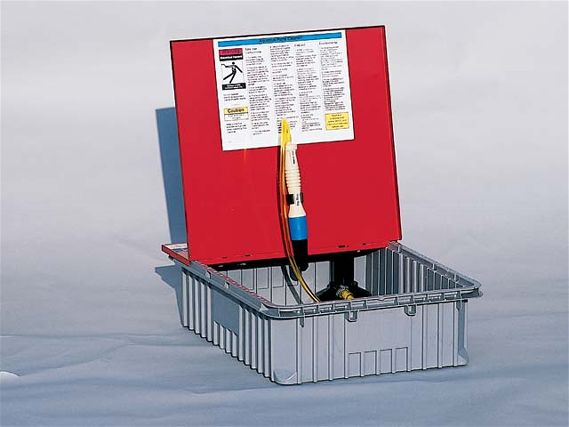 | Kafko International Tabletop Parts Cleaner
| Kafko International Tabletop Parts Cleaner
Cleaning parts has to be the least fun part of working on cars. I was taught to work on cars by someone who himself learned in the early '60s. So I started out cleaning black gunk off filthy GM parts with a bucket of kerosene and a little wire brush. I recently adapted struts and brake assemblies from a 20-year-old car to one 30 years old. By the time it was all over, I had probably spent a day cleaning. I used nitrile gloves and water-soluble cleaning solutions, but I was still squatting outside my shop with scrapers, brushes and pans of dirty cleaning solution. It sucked. I've been researching parts washers since the day I moved into my shop. There are big solvent tanks, intended to be used with kerosene or equivalent. Besides the fact that they aren't legal in California, I don't need that liability, and I don't need to breathe the vapors while I use it. Technology is swell, and there are now heated, aqueous parts washers that use oil-metabolizing sea monkeys to eliminate the oil. There is a filter that must be changed, but it can be treated as ordinary refuse. Such a system is ideal but takes up valuable floor space and is expensive enough to be considered only by professional shops using it every day. I've tried a few different cleaning solutions with various combinations of biodegradable, non-toxic and water-based features with mixed results.
At last year's SEMA Show, I found Kafko International, which displayed a hobby-sized, table- top parts cleaner intended to be used with its Oil Eater Cleaner/Degreaser solution. I had a hunch my search was over. With a 4-gal. capacity, the table-top parts cleaner is just big enough for the home user. It has a built-in centrifugal pump with an on-off switch in the cord. All the parts that are exposed to the Oil Eater/water solution are plastic to avoid corrosion. The steel cover is powdercoated. Oil Eater solution flows through the brush.
Oil Eater consists of non-ionic surfactants, emulsifiers, water softeners and other biodegradable ingredients. It has a light, citrus odor and is water-soluble, so it is easily diluted or used full-strength. A material safety data sheet check reveals it's wisest to use neoprene gloves and whatever other normal gear would be used to protect against chemical splashes, and to have an open window or door, but it's rather benign in the world of degreasers. Remember, anything that's ever been cleaned is in solution, though.
The parts cleaner arrived with all the parts and a gallon of Oil Eater inside the polyethylene tank and took just a few minutes to assemble. A tear-down bench next to the main door is a perfect location for the parts cleaner to live. Once it was set up and the Oil Eater mixed with water in the tub, I looked around for the greasiest, nastiest part I could find in the shop, which ended up being a CV axle. I couldn't believe how quickly the axle came clean. The Oil Eater solution cut right through the built-up oil, grease and grime, with a factor of ten or more in speed versus old methods. A quick water rinse, and the axle was ready to go.
The only problem I've had is that with the small, shallow tub and the pump's generous capacity, I tend to splash drops of the solution on the surrounding area. Eventually, the fluid will have enough oil and grease dissolved in it that it will have to be changed, and it may be a challenge to find a proper means of disposal, but it will certainly be easier than if the solution was a hydrocarbon solvent.
I am certain that the Kafko International table-top parts cleaner will take its place in the rotation of "Best Tool in the World," and am looking forward to wondering how I ever got along without it. The answer is, I barely did.
